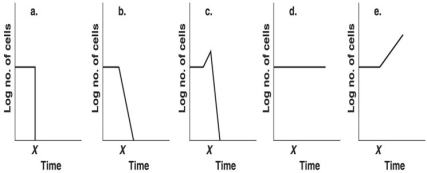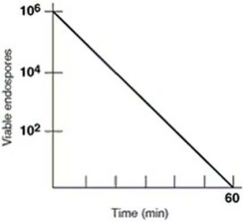B) False
Correct Answer

verified
Correct Answer
verified
Multiple Choice
Disinfection of water is achieved by all of the following EXCEPT
A) chlorine.
B) copper sulfate.
C) peracetic acid.
D) ozone.
E) UV radiation.
G) B) and C)
Correct Answer

verified
Correct Answer
verified
Multiple Choice
Which of the following pairs is mismatched?
A) ionizing radiation hydroxyl radicals
B) ultraviolet radiation desiccation
C) supercritical fluids Co2
D) plasma sterilization free radicals
E) ozone takes electrons from substances
G) A) and B)
Correct Answer

verified
Correct Answer
verified
Multiple Choice
Figure 7.2
Assume 109 E. coli cells/ml are in a flask.
 -Which graph in Figure 7.2 best depicts the effect of placing the culture at 7°C at time x?
-Which graph in Figure 7.2 best depicts the effect of placing the culture at 7°C at time x?
A) a
B) b
C) c
D) d
E) e
G) All of the above
Correct Answer

verified
Correct Answer
verified
True/False
Pseudomonas has been found growing in quaternary ammonium compounds (quats).
B) False
Correct Answer

verified
Correct Answer
verified
Multiple Choice
Which of the following best describes the pattern of microbial death?
A) The cells in a population die at a constant rate.
B) Not all of the cells in a culture are killed.
C) The pattern varies depending on the species.
D) All the cells in a culture die at once.
E) The pattern varies depending on the antimicrobial agent.
G) A) and E)
Correct Answer

verified
Correct Answer
verified
Multiple Choice
Table 7.3 The following data were obtained by incubating gram -positive bacteria in nutrient medium + disinfectant for 24 hr, then transferring one loopful to nutrient medium (subculturing) . (+ = growth; - = no growth) -In Table 7.3, which disinfectant is the most effective at stopping bacterial growth?
A) Doom
B) K.O.
C) Mortum
D) Sterl
E) The answer cannot be determined based on the information provided.
G) B) and E)
Correct Answer

verified
Correct Answer
verified
Multiple Choice
Figure 7.1
 A suspension of 106 Bacillus cereus endospores was put in a hot-air oven at 170°C. Plate counts were used to determine the number of endospores surviving at the time intervals shown.
-In Figure 7.1, the decimal reduction time (D value) for the culture, which is defined as the time to reduce a population by one log, is approximately
A suspension of 106 Bacillus cereus endospores was put in a hot-air oven at 170°C. Plate counts were used to determine the number of endospores surviving at the time intervals shown.
-In Figure 7.1, the decimal reduction time (D value) for the culture, which is defined as the time to reduce a population by one log, is approximately
A) 40 minutes.
B) 30 minutes.
C) 0 minutes.
D) 10 minutes.
E) 60 minutes.
G) B) and E)
Correct Answer

verified
Correct Answer
verified
Multiple Choice
Table 7.1 A disk-diffusion test using Staphylococcus gave the following results: -In Table 7.1, which compound was the most effective against E. coli?
A) A
B) B
C) C
D) D
E) The answer cannot be determined based on the information provided.
G) B) and E)
Correct Answer

verified
Correct Answer
verified
Multiple Choice
Which concentration of ethanol is the most effective bactericide?
A) 50 percent
B) 30 percent
C) 40 percent
D) 100 percent
E) 70 percent
G) A) and B)
Correct Answer

verified
Correct Answer
verified
True/False
Some antimicrobial chemicals are considered to be disinfectants and antiseptics.
B) False
Correct Answer

verified
Correct Answer
verified
Multiple Choice
The preservation of beef jerky from microbial growth relies on which method of microbial control?
A) supercritical Co2
B) filtration
C) desiccation
D) ionizing radiation
E) lyophilization
G) A) and C)
Correct Answer

verified
Correct Answer
verified
Multiple Choice
Oxidizing agents include all of the following EXCEPT
A) iodine.
B) glutaraldehyde.
C) hydrogen peroxide.
D) chlorine.
E) ozone.
G) A) and D)
Correct Answer

verified
Correct Answer
verified
Multiple Choice
Figure 7.1
 A suspension of 106 Bacillus cereus endospores was put in a hot-air oven at 170°C. Plate counts were used to determine the number of endospores surviving at the time intervals shown.
-In Figure 7.1, the thermal death point for this culture is
A suspension of 106 Bacillus cereus endospores was put in a hot-air oven at 170°C. Plate counts were used to determine the number of endospores surviving at the time intervals shown.
-In Figure 7.1, the thermal death point for this culture is
A) 15 minutes.
B) 30 minutes.
C) 50°C.
D) 170°C.
E) The answer cannot be determined based on the information provided
G) A) and C)
Correct Answer

verified
Correct Answer
verified
Multiple Choice
Which of the following is the best method to sterilize heat-labile solutions?
A) freezing
B) dry heat
C) pasteurization
D) membrane filtration
E) autoclave
G) A) and B)
Correct Answer

verified
Correct Answer
verified
Multiple Choice
Table 7.1 A disk-diffusion test using Staphylococcus gave the following results: -In Table 7.1, which compound was bactericidal?
A) A
B) B
C) C
D) D
E) The answer cannot be determined based on the information provided.
G) A) and D)
Correct Answer

verified
Correct Answer
verified
Multiple Choice
Figure 7.1
 A suspension of 106 Bacillus cereus endospores was put in a hot-air oven at 170°C. Plate counts were used to determine the number of endospores surviving at the time intervals shown.
-Which of the following results in lethal damage to nucleic acids?
A suspension of 106 Bacillus cereus endospores was put in a hot-air oven at 170°C. Plate counts were used to determine the number of endospores surviving at the time intervals shown.
-Which of the following results in lethal damage to nucleic acids?
A) heat
B) radiation
C) certain chemicals
D) heat and radiation
E) heat, radiation, and some chemicals
G) B) and D)
Correct Answer

verified
Correct Answer
verified
Multiple Choice
All of the following factors contribute to hospital-acquired infections EXCEPT
A) some bacteria metabolize disinfectants.
B) bacteria may be present in commercial products such as mouthwash.
C) gram-negative bacteria are often resistant to disinfectants.
D) invasive procedures can provide a portal of entry for bacteria.
E) None of the answers is correct; all of these factors may contribute to hospital -acquired infection.
G) C) and E)
Correct Answer

verified
Correct Answer
verified
Multiple Choice
Table 7.1 A disk-diffusion test using Staphylococcus gave the following results: -In Table 7.1, which compound was the most effective against Staphylococcus?
A) A
B) B
C) C
D) D
E) The answer cannot be determined based on the information provided.
G) None of the above
Correct Answer

verified
Correct Answer
verified
Multiple Choice
Which of the following regarding antimicrobial control agents is FALSE?
A) A true antimicrobial control agent is equally effective against both bacteria and viruses.
B) Contaminating organic debris such as blood or sputum will decrease effectiveness.
C) Some agents kill by denaturing microbial cell proteins.
D) Some agents are utilized as both an antiseptic and a disinfectant.
E) Some agents affect microbial cell membranes by dissolving lipids.
G) B) and E)
Correct Answer

verified
Correct Answer
verified
Showing 21 - 40 of 63
Related Exams